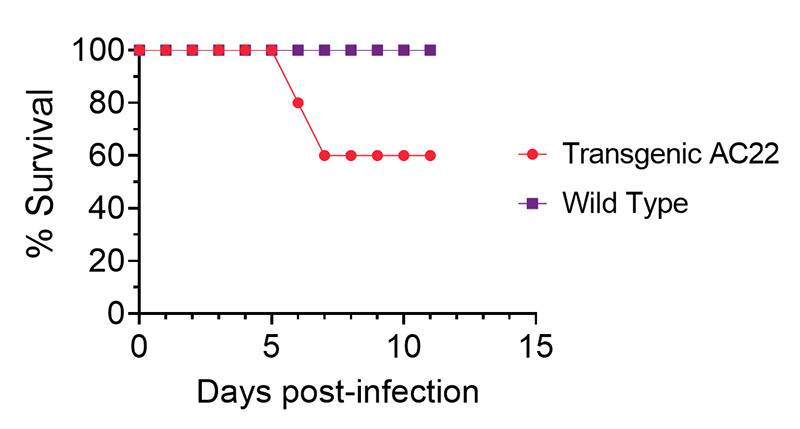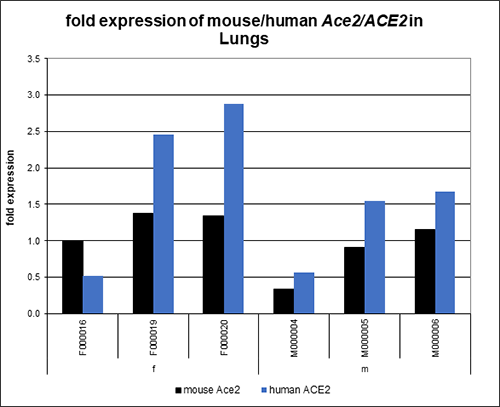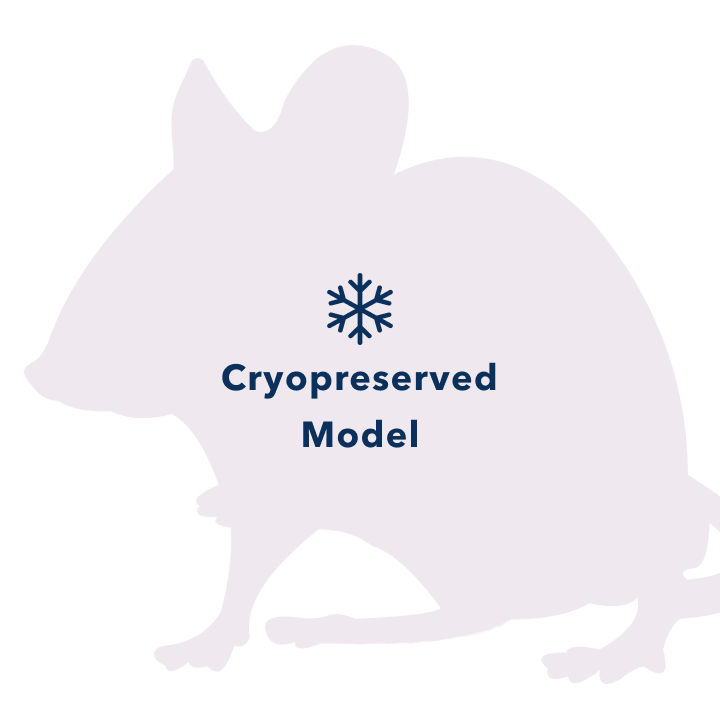| Model No. | Nomenclature | Genotype |
|---|---|---|
| 18225 | B6;C3(C)-Tg(CAG-ACE2)22Ctkt | tg/wt |
| 18225-F | B6;C3(C)-Tg(CAG-ACE2)22Ctkt | wt/wt |
| 18225-M | B6;C3(C)-Tg(CAG-ACE2)22Ctkt | tg/wt |
hACE2 AC22 Mouse

- Description
- Data
- Price & Licensing
- Overview
- Genetics
- Guides & Publications
- Applications & Therapeutic Areas
- Transit, Housing & Welfare
- Diet
Overview
Nomenclature: B6;C3(C)-Tg(CAG-ACE2)22Ctkt
- Mice expressing human ACE2 are susceptible to infection by SARS-CoV-2, the virus that causes COVID-19. The hACE2 AC22 mouse model expresses human ACE2 cDNA under the control of the CAG promoter.
- ACE2 is the receptor bound by SARS-CoV-2 and SARS-CoV spike proteins during viral entry into host cells; these spike proteins have much higher binding affinity to human ACE2 compared to mouse ACE2.
- hACE2 AC22 are lethality-resistant and may be useful for studies of sublethal SARS-CoV-2 infection. A SARS-CoV-2 dose (105 TCID50) that is fully lethal in hACE2 AC70 mice results in only partial lethality in hACE2 AC22 mice, and viral titration will likely provide sharper resolution to sublethal effects of SARS-CoV-2 in the AC22 line. For experiments where a lethal SARS-CoV-2 infection model is preferred, we recommend hACE2 AC70.
- Following intranasal infection with 105 TCID50 SARS-CoV-2, 40% of AC22 mice died by 7 dpi. Personal communication, Kent Tseng, UTMB.
- hACE2 AC22 mice express human ACE2 in lungs, kidney, brain, stomach, small intestine, cecum, colon, muscle and heart.
- Due to the susceptibility of this mouse to SARS-CoV-2 and the current prevalence of this virus in the human population, special biosecurity precautions are required for housing and husbandry for hACE2 mice — both naïve mice and mice used in infection studies. Due to the susceptibility of this mouse to SARS-CoV-2, these mice should be handled in a manner consistent with appropriate guidelines for prevention of human infection with the SARS-CoV-2 virus. Proper PPE and handling methods should be used at all times. Learn more here.
- The hACE2 AC22 line is also susceptible to SARS-CoV, the virus which causes SARS. Following intra-nasal infection with SARS-CoV, hACE2 AC22 mice lose weight (~30%) but recover without observed mortality. SARS-CoV virus replicates primarily in lung and, to a lesser extent, brain, and hACE2 AC22 mice develop moderate interstitial pneumonia.
- The AC22 transgene is integrated into an unplaced scaffold region, presumably on chromosome 10. It is estimated at 30-40 copies.
- Learn more about hACE2 mice for COVID-19 research.
- Non-profit researchers may obtain breeding rights by executing a limited breeding license. This license carries a nominal fee.
| hACE2 Strain | AC70 | AC22 | Rosa26-K18 | |
| Taconic Model # | 18222 | 18225 | 18675 | |
| Nomenclature | B6;C3-Tg(CAG-ACE2)70Ctkt | B6;C3(C)-Tg(CAG-ACE2)22Ctkt | C57BL/6NTac-Gt(ROSA)26Sortm7373_A-A10(KRT18-ACE2)Tac | |
| Transgene Location | X chromosome | Unplaced scaffold region, presumably on chromosome 10 | Rosa26 locus (safe harbor) on chromosome 6, under control of the K18 promoter | |
| Transgene Copy Number | 1 | ~30–40 | 1 | |
| SARS-CoV-2 Dose (US_WA-1/2020) | 103–106 TCID50 | 101 TCID50 | 105 TCID50 | 104 PFU (or ~103.8TCID50) |
| SARS-CoV-2 Dose (Delta B.1.617.2 variant) | N/A | N/A | 104 PFU (or ~103.8TCID50) | |
| SARS-CoV-2 Dose (Omicron BA.1 variant) | N/A | N/A | 104 PFU (or ~103.8TCID50) | |
| Mortality | 100% | 100% | 30–40% | WA-1 and Delta: 25% |
| Survival (days post-infection) | 4–5 | 6–10 | 7 | 15-65 depending on viral strain/titer |
| Clinical Signs | Severe weight loss, lethal infection | Moderate–severe weight loss, lethal infection | Moderate weight loss; lethal infection in some mice | Increased systemic inflammatory response |
| Site of Viral Replication | Primarily lung and brain | Primarily lung and brain | Primarily lung and brain | Primarily lung |
| Sex Differences | Minimal sex differences observed | Some sex differences observed; males display more severe disease phenotype | ||
| Other Information | LD50: 3 TCID50 ID50: 0.5 TCID50 | ID50: 101.5 TCID50 (~30 TCID50) | LD50: 1.84 x 104 PFU | |
Orders by weight: Taconic cannot accept orders by weight for this model. Please note that shipments may contain animals with a larger weight variation.
Origin
hACE2 AC22 provides a lethality-resistant model for SARS-CoV-2 infection

This model is cryopreserved and available for recovery. Models can typically be recovered and delivered to customers within 12 weeks after order receipt. Purchase of this model includes perpetual use rights and a deliverable of four mutant animals at the Murine Pathogen Free™ health standard along with a genotyping protocol. For models which include a recombinase gene or multiple alleles, all alleles will be provided, but individual animals may not contain all mutant alleles.
Taconic’s Colony Management experts can design a plan to grow your colony faster.
Genetics
Guides & Publications
Initial Publication:
- Tseng, C.-T. K.; Huang, C.; Newman, P.; Wang, N.; Narayanan, K.; Watts, D. M.; Makino, S.; Packard, M. M.; Zaki, S. R.; Chan, T.-S.; Peters, C. J. Severe Acute Respiratory Syndrome Coronavirus Infection of Mice Transgenic for the Human Angiotensin-Converting Enzyme 2 Virus Receptor. Journal of Virology 2007, 81 (3), 1162–1173.
- Yoshikawa, N.; Yoshikawa, T.; Hill, T.; Huang, C.; Watts, D. M.; Makino, S.; Milligan, G.; Chan, T.; Peters, C. J.; Tseng, C.-T. K. Differential Virological and Immunological Outcome of Severe Acute Respiratory Syndrome Coronavirus Infection in Susceptible and Resistant Transgenic Mice Expressing Human Angiotensin-Converting Enzyme 2. Journal of Virology 2009, 83 (11), 5451–5465.
Applications & Therapeutic Areas
- Infectious Disease
Transit, Housing & Welfare
Need more info? Click the live chat button or Contact Us
Diet
Data

Figure 1: hACE2 AC22 mice are permissive to SARS-CoV-2 infection with 40% mortality when challenged with 105 TCID50. Female human ACE2 transgene-positive (Transgenic AC22) and -negative (Wild Type) littermates from the AC22 line were infected intranasally with 105 TCID50 of SARS-CoV-2 (US_WA-1/2020). Following intranasal infection with 105 TCID50 SARS-CoV-2, 40% of AC22 mice died by 7 dpi. Personal communication, Kent Tseng, UTMB. 
Figure 2: hACE2 AC22 mice generally express higher levels of human ACE2 mRNA in the lung compared to mouse Ace2 mRNA.
- Licensing
- Select my Health Standard
- Get Custom Pricing Guide
hACE2 AC22 Mouse
This model is sold under terms which grant perpetual use rights.
Select my Health Standard
Need help choosing the right Taconic Biosciences health standard for your research?
Use the Health Standard Selector to enter your exclusion list. The tool will tell you which health standards meet your requirements.
Get custom pricing guide
Schedule A Scientific Consultation
Connect directly with a member of our Scientific Solutions team who can help you select the most appropriate model and maximize your experimental success.
















.jpg)

.jpg)
.jpg)
.jpg)
.jpg)





.jpg)


.jpg)
.jpg)




.jpg)




.jpg)

.jpg)








